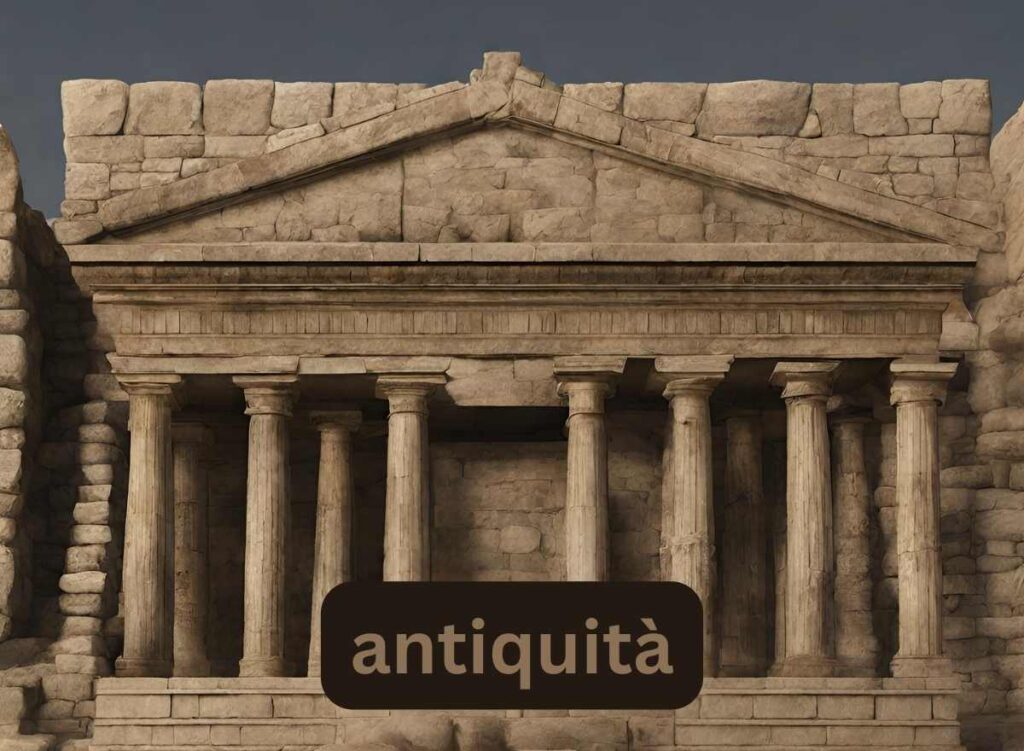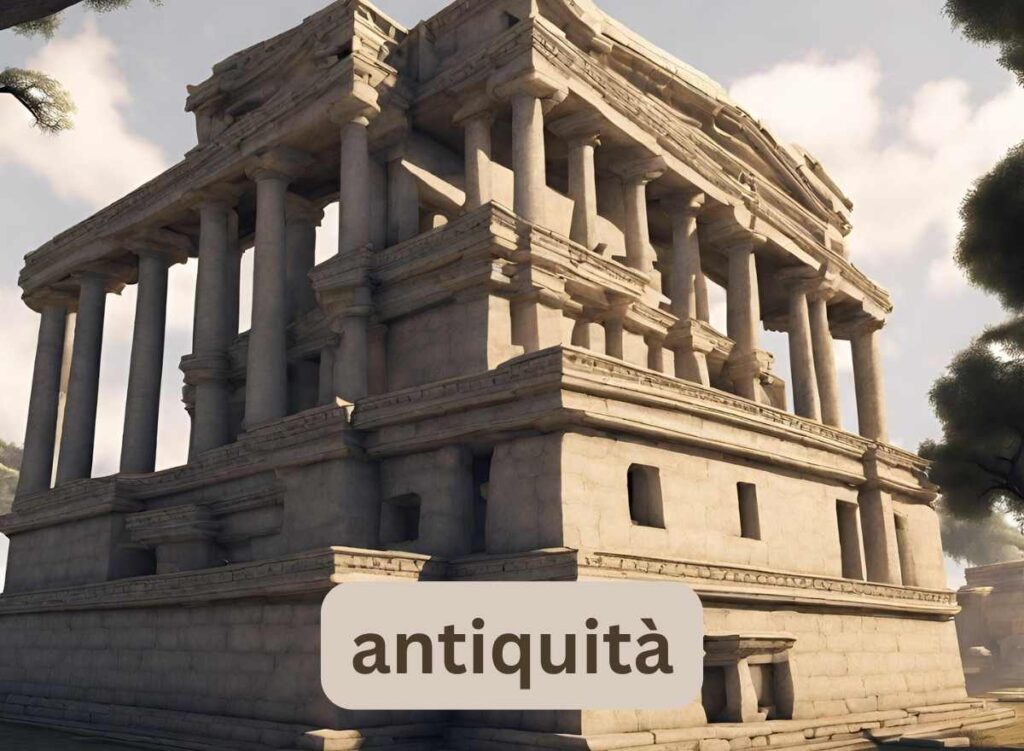
The word “antiquità” carries with it the weight of centuries, encapsulating a world of historical richness and cultural significance that transcends the boundaries of time.
It is more than a mere term; it is an invitation to explore the ancient history and culture of the Mediterranean region, with a particular focus on the civilizations of ancient Greece and Rome.
In this detailed exploration, we embark on a grand journey through the various dimensions that make antiquità a treasure trove of human experience, weaving together threads of history, art, and evolution.
Defining Antiquità: Peering into the Ancient Past

Antiquità, derived from the Latin word “antiquitas,” is a linguistic bridge to “ancient times” or “antiquity.”
It spans a period from the 8th century BC to the 5th century AD, encapsulating the Iron Age and the Classical Age of the Mediterranean region.
This term beckons us to a time characterized by the emergence of remarkable civilizations—the ancient Greeks, Romans, Egyptians, Persians, Phoenicians, and Carthaginians.
Beyond a linguistic definition, antiquità embodies the remnants of this bygone era, offering a window into the lives, cultures, and societal norms of ancient civilizations.
It serves as a portal, enabling us to peer into the intricacies of a world vastly different from our own.
The Archaeological Odyssey: Unveiling Stories Buried in Time
At the heart of antiquità lies the captivating realm of archaeology. An ongoing odyssey unfolds as scientists and historians meticulously excavate remnants that tell tales of ancient civilizations.
The archaeological journey unearths a mosaic of artifacts—from humble pottery and tools to grandiose structures.
Each discovery contributes to the unfolding narrative of human history, providing insights into societal intricacies, technological advancements, and cultural nuances of antiquity.
The excavation sites become time machines, transporting us back to an era where every piece of pottery, every tool, whispers stories of daily life, trade, and technological prowess.
The archaeological odyssey becomes a testament to human curiosity and the relentless pursuit of understanding our roots.
Artistic Splendors of Antiquità: A Reflection of Creativity and Expression
The art of antiquità is a testament to the creativity and craftsmanship of our ancestors. Intricate sculptures, awe-inspiring mosaics, and breathtaking paintings transport us to a world where art was not just a skill but a profound cultural expression.
These artistic splendors serve as windows into the aesthetics that defined ancient societies.
Consider the ancient Greeks—their sculptures, with their attention to detail, capture the human form in a way that reflects a deep appreciation for beauty and proportion.
Mosaics from ancient Rome tell tales of daily life, while Egyptian paintings provide glimpses into the religious and symbolic aspects of their culture.
Exploring these artistic treasures allows us not only to appreciate the technical skill but also to understand the values and beliefs embedded in their visual narratives.
Antiquità in Architecture: Structures as Silent Witnesses to History
From the grandeur of the Egyptian pyramids to the intricate design of Greek temples, antiquità is etched into the architecture of ancient civilizations.
These structures go beyond showcasing architectural prowess; they offer profound insights into the beliefs, values, and societal structures of bygone eras.
Consider the Parthenon in Athens—a marvel of classical Greek architecture. Its columns and friezes not only showcase technical excellence but also embody the ideals of democracy and civic pride.
The pyramids of Egypt, with their monumental scale and precision, reflect a society deeply rooted in religious beliefs and a fascination with the afterlife.
Each column, arch, and facade stands as a silent witness to the passage of time, inviting contemplation on the evolution of human ingenuity.
Preserving Antiquità: Challenges and Triumphs in Conservation
Preserving antiquità is a challenge that extends beyond the realm of archaeology.
The ravages of time, environmental factors, and human activities threaten the integrity of ancient artifacts and structures.
However, dedicated efforts in conservation and restoration work tirelessly to safeguard these treasures for future generations.
Conservationists face the delicate task of balancing the preservation of authenticity with the need to protect artifacts from further deterioration.
Whether it’s the restoration of crumbling frescoes in Pompeii or the stabilization of ancient manuscripts, each endeavor is a triumph against the relentless march of time.
Conservation not only preserves the physical remnants of antiquity but also ensures that the stories embedded in these artifacts continue to resonate with generations to come.
The Enduring Allure of Antiquità: A Timeless Connection

Despite the vast temporal gap that separates us from antiquità, there exists an enduring allure that draws us toward the past.
It is the mystique of ancient civilizations, the timeless beauty of art and architecture, and the connection to our shared human history that transcends time and borders.
Our fascination with antiquità is not merely an academic pursuit; it is a recognition of the profound impact that ancient cultures have had on the modern world.
Whether it’s the democratic ideals of ancient Greece, the legal systems inherited from Rome, or the enduring influence of Egyptian symbols, our connection to antiquity is deeply embedded in our daily lives.
In understanding and appreciating the antiquities of the world, we find a profound connection to our shared human history.
It becomes a bridge between epochs, weaving a tapestry of shared human experiences that traverses continents and cultures.
Frequently Asked Questions(FAQs)
Q1: What does the term “Antiquità” mean?
“Antiquità” is derived from the Latin word “antiquitas,” meaning “ancient times” or “antiquity.” It refers to the ancient history and culture of the Mediterranean region, with a focus on civilizations such as ancient Greece and Rome.
Q2: What is the historical timeframe covered by Antiquità?
Antiquità spans from the 8th century BC to the 5th century AD, encompassing the Iron Age and the Classical Age of the Mediterranean region.
Q3: What civilizations are associated with Antiquità?
Antiquità is associated with several remarkable civilizations, including the ancient Greeks, Romans, Egyptians, Persians, Phoenicians, and Carthaginians.
Q4: What is the significance of the term in the field of study?
Antiquità is a multidisciplinary and interdisciplinary field that explores the art, literature, philosophy, religion, politics, and society of ancient civilizations, using sources such as archaeological remains, inscriptions, coins, sculptures, paintings, and manuscripts.
Q5: What are some highlights and achievements of Antiquità?
Notable achievements of Antiquità include the founding of Western civilization by ancient Greeks, the expansion of the Roman Empire, the enduring civilization of ancient Egyptians, the powerful Persian Empire, maritime trade pioneered by Phoenicians, and the rivalry between Carthage and Rome.
Q6: Why is Antiquità still relevant today?
Antiquità is relevant as it serves as the source of many modern ideas, values, and institutions, influences cultural and artistic expressions, and acts as a bridge between diverse cultures, fostering dialogue and cooperation.
Q7: What role does archaeology play in Antiquità?
Archaeology is central to Antiquità, as it involves the meticulous excavation of remnants from ancient civilizations, providing insights into daily life, trade, technological advancements, and cultural nuances.
Q8: How does Antiquità manifest in artistic expressions?
The art of Antiquità, including sculptures, mosaics, and paintings, reflects the creativity and cultural expressions of ancient societies, offering a visual narrative of their values and beliefs.
Q9: What is the significance of Antiquità in architecture?
Antiquità is etched into the architecture of ancient civilizations, such as the Egyptian pyramids and Greek temples, serving as silent witnesses to the beliefs, values, and societal structures of the past.
Q10: How is Antiquità preserved for future generations?
Preservation efforts, including conservation and restoration, work to safeguard ancient artifacts and structures from the ravages of time, environmental factors, and human activities, ensuring the legacy of Antiquità endures.
Conclusion: Navigating the Seas of Time through Antiquità
In conclusion, antiquità is not just a term; it unfolds as a multifaceted journey into the annals of history, art, and human civilization.
As we navigate the seas of time through the remnants of the past, we gain a deeper understanding of our collective heritage.
Antiquità beckons us to explore, appreciate, and preserve the treasures that bind us to the roots of our existence.
This grand tapestry of antiquità, woven with threads of linguistic exploration, archaeological odysseys, artistic splendors, architectural marvels, conservation challenges, and enduring allure, serves as a testament to the resilience of human culture and the timeless connection that binds us across generations.
It invites us to delve into the richness of the past, not merely as spectators but as active participants in the ongoing narrative of human civilization.








